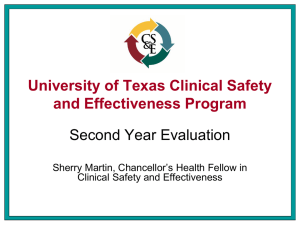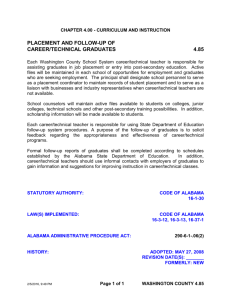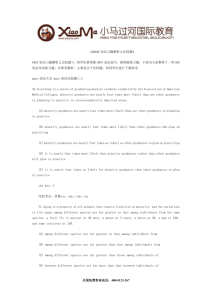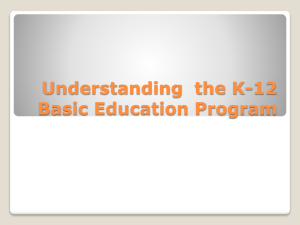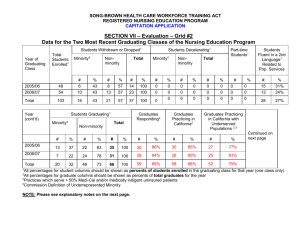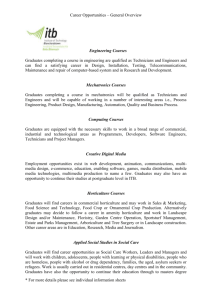Clinical Safety and Effectiveness Quality Improvement Course
advertisement
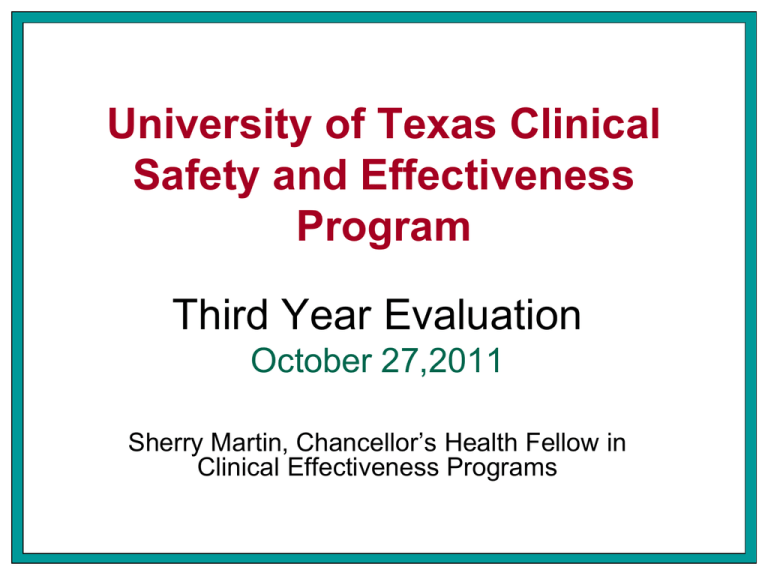
University of Texas Clinical Safety and Effectiveness Program Third Year Evaluation October 27,2011 Sherry Martin, Chancellor’s Health Fellow in Clinical Effectiveness Programs University of Texas Clinical Safety and Effectiveness Program Goal: • To integrate quality and safety concepts into the way we do our work everyday and enhance organizational knowledge through disseminated successful practices across the UT System – The Clinical Safety and Effectiveness (CS&E) quality improvement course – Annual conference and recognition event – University of Texas CS&E Fellowship Core CS&E Quality Improvement Course The purpose of the CS&E course is to establish a critical mass of clinicians able to lead improvement efforts and serve as faculty for the course to make improvement practices part of daily operations UT CS&E Course Objectives and Related Measures • Establish the course at each of the UT healthcare organizations – # of organizations achieving full implementation • Reach a critical mass of graduates, completing successful projects and leading improvement efforts – # of graduates – # of successful projects – % of graduates leading improvement initiatives – # of publications and presentations by graduates CS&E Course Implementation Third Year Results • Fully implemented at MDACC, UTHSC – Houston, UTSW, and UTHSCSA – 936 Graduates + 35 enrolled – 328 Completed projects + 18 underway • UTMB – preparing for first class graduation in 2012 • UTHSC-Tyler faculty graduates provide organizational project mentorship and oversight • All campuses have course graduates CS&E Course Implementation Third Year Results CS&E Annual Survey of Graduates • Purpose: – Determine extent to which course goals are achieved – Identify opportunities for improvement – Identify individuals demonstrating exceptional quality improvement expertise • Electronic survey • 2011 response – 18% University of Texas CS&E Annual Conference and Recognition Event • Goals: – Transfer learning and applicable best practices across the UT health care organizations – Recognize exceptional individual and team improvement efforts – Develop ideas and concepts to drive system-wide improvement initiatives UT CS&E Conference Organizational Learning Goal Measures • # of conference participants/ % satisfaction • # of abstracts accepted for presentation • # of participants adopting CS&E project practices • # of projects achieving sustained results • $ achieved through cost avoidance or revenue enhancement Second Year CS&E Conference Results • 80 abstracts accepted • 233 participants • “Overall satisfaction”- 74% “excellent”; 98% “excellent/good” “Identify strategies to adopt new ‘best practices’ 52% “excellent”; 92% “excellent/good Third Year CS&E Conference Results • 83 abstracts accepted for presentation • Score to be considered for awards = greater than 825 • Registration = 250 • One project submitted under “Adopted ” • Five demonstrated sustained results over 2 years or more • 18 publications by CS&E graduates in peer-reviewed journals; numerous graduates presented at national and state meetings Course/Conference Results Quality Pays! The “return-on-investment” for the projects presented at the 2011 conference: • $2.2M in project revenue, realized • $0.9M in project cost avoidance, realized ( assuming 50% reimbursement) • $3.7M projected savings/revenue if even 50% of the projections are realized • $6.8M = Total gain UT System Fellowship Program • Goal: Establish a body of healthcare providers who demonstrate exceptional improvement expertise and commitment to apply these skills to make regular improvements and to educate others • Inducted 16 Fellows from all six UT health care organizations New Curriculum Concepts • Lean Thinking and/or Six Sigma – all campuses • Team STEPPS – UTHSCSA • Crew Resource Management – UTSW, UTHSCSA • Disclosure Training – UTHSCH, UTHSCSA Graduate and Undergraduate Training Programs • Integrated quality and patient safety interprofessional education into medical and nursing students curriculum • Established internal medicine and family medicine residency rotations focused on CS&E principles • Provide quality principles at ground rounds Web –Based Training • IHI Open School courses suitable for all health professions - five sites • Quality College, courses at all levels, resulting in certification – MDACC • Office Time – courses in Microsoft Office graphing principles - UTSW
